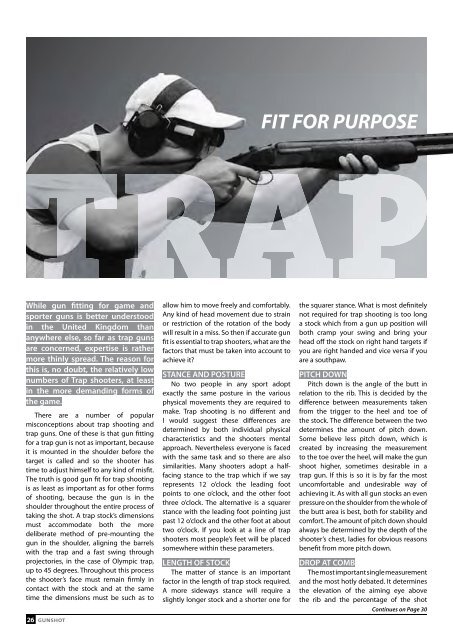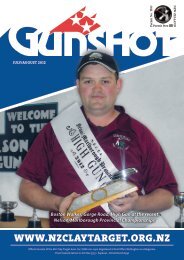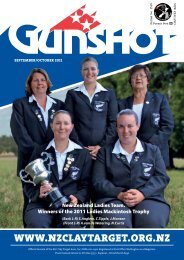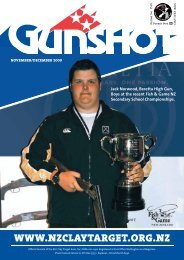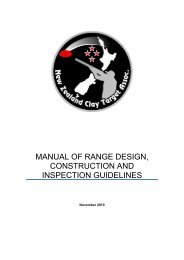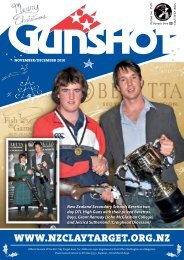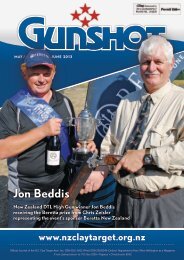2010 - New Zealand Clay Target Association
2010 - New Zealand Clay Target Association
2010 - New Zealand Clay Target Association
You also want an ePaper? Increase the reach of your titles
YUMPU automatically turns print PDFs into web optimized ePapers that Google loves.
While gun fitting for game and<br />
sporter guns is better understood<br />
in the united Kingdom than<br />
anywhere else, so far as trap guns<br />
are concerned, expertise is rather<br />
more thinly spread. the reason for<br />
this is, no doubt, the relatively low<br />
numbers of trap shooters, at least<br />
in the more demanding forms of<br />
the game.<br />
There are a number of popular<br />
misconceptions about trap shooting and<br />
trap guns. One of these is that gun fitting<br />
for a trap gun is not as important, because<br />
it is mounted in the shoulder before the<br />
target is called and so the shooter has<br />
time to adjust himself to any kind of misfit.<br />
The truth is good gun fit for trap shooting<br />
is as least as important as for other forms<br />
of shooting, because the gun is in the<br />
shoulder throughout the entire process of<br />
taking the shot. A trap stock’s dimensions<br />
must accommodate both the more<br />
deliberate method of pre-mounting the<br />
gun in the shoulder, aligning the barrels<br />
with the trap and a fast swing through<br />
projectories, in the case of Olympic trap,<br />
up to 45 degrees. Throughout this process<br />
the shooter’s face must remain firmly in<br />
contact with the stock and at the same<br />
time the dimensions must be such as to<br />
26 gunshot<br />
allow him to move freely and comfortably.<br />
Any kind of head movement due to strain<br />
or restriction of the rotation of the body<br />
will result in a miss. So then if accurate gun<br />
fit is essential to trap shooters, what are the<br />
factors that must be taken into account to<br />
achieve it<br />
stANCe AND POstuRe<br />
No two people in any sport adopt<br />
exactly the same posture in the various<br />
physical movements they are required to<br />
make. Trap shooting is no different and<br />
I would suggest these differences are<br />
determined by both individual physical<br />
characteristics and the shooters mental<br />
approach. Nevertheless everyone is faced<br />
with the same task and so there are also<br />
similarities. Many shooters adopt a halffacing<br />
stance to the trap which if we say<br />
represents 12 o’clock the leading foot<br />
points to one o’clock, and the other foot<br />
three o’clock. The alternative is a squarer<br />
stance with the leading foot pointing just<br />
past 12 o’clock and the other foot at about<br />
two o’clock. If you look at a line of trap<br />
shooters most people’s feet will be placed<br />
somewhere within these parameters.<br />
leNGtH OF stOCK<br />
The matter of stance is an important<br />
factor in the length of trap stock required.<br />
A more sideways stance will require a<br />
slightly longer stock and a shorter one for<br />
the squarer stance. What is most definitely<br />
not required for trap shooting is too long<br />
a stock which from a gun up position will<br />
both cramp your swing and bring your<br />
head off the stock on right hand targets if<br />
you are right handed and vice versa if you<br />
are a southpaw.<br />
PItCH DOWN<br />
Pitch down is the angle of the butt in<br />
relation to the rib. This is decided by the<br />
difference between measurements taken<br />
from the trigger to the heel and toe of<br />
the stock. The difference between the two<br />
determines the amount of pitch down.<br />
Some believe less pitch down, which is<br />
created by increasing the measurement<br />
to the toe over the heel, will make the gun<br />
shoot higher, sometimes desirable in a<br />
trap gun. If this is so it is by far the most<br />
uncomfortable and undesirable way of<br />
achieving it. As with all gun stocks an even<br />
pressure on the shoulder from the whole of<br />
the butt area is best, both for stability and<br />
comfort. The amount of pitch down should<br />
always be determined by the depth of the<br />
shooter’s chest, ladies for obvious reasons<br />
benefit from more pitch down.<br />
DROP At COMB<br />
The most important single measurement<br />
and the most hotly debated. It determines<br />
the elevation of the aiming eye above<br />
the rib and the percentage of the shot<br />
Continues on Page 30


